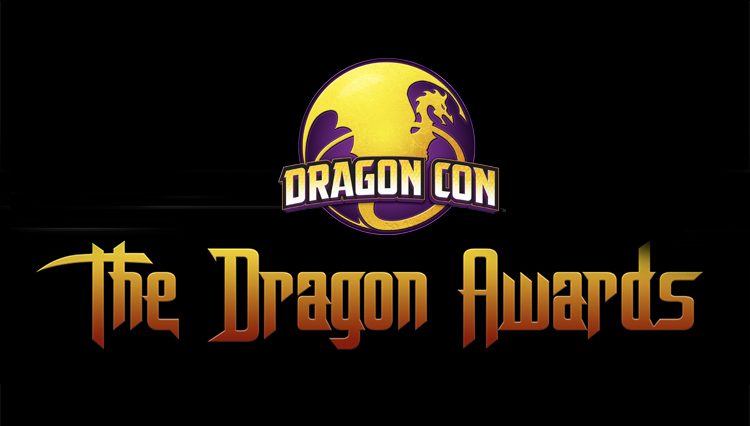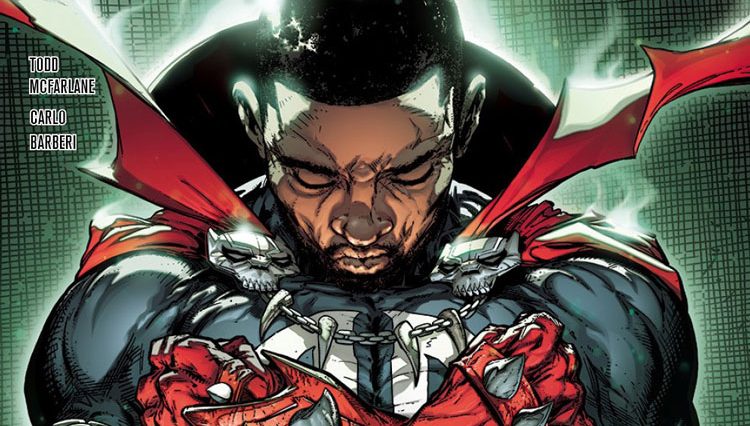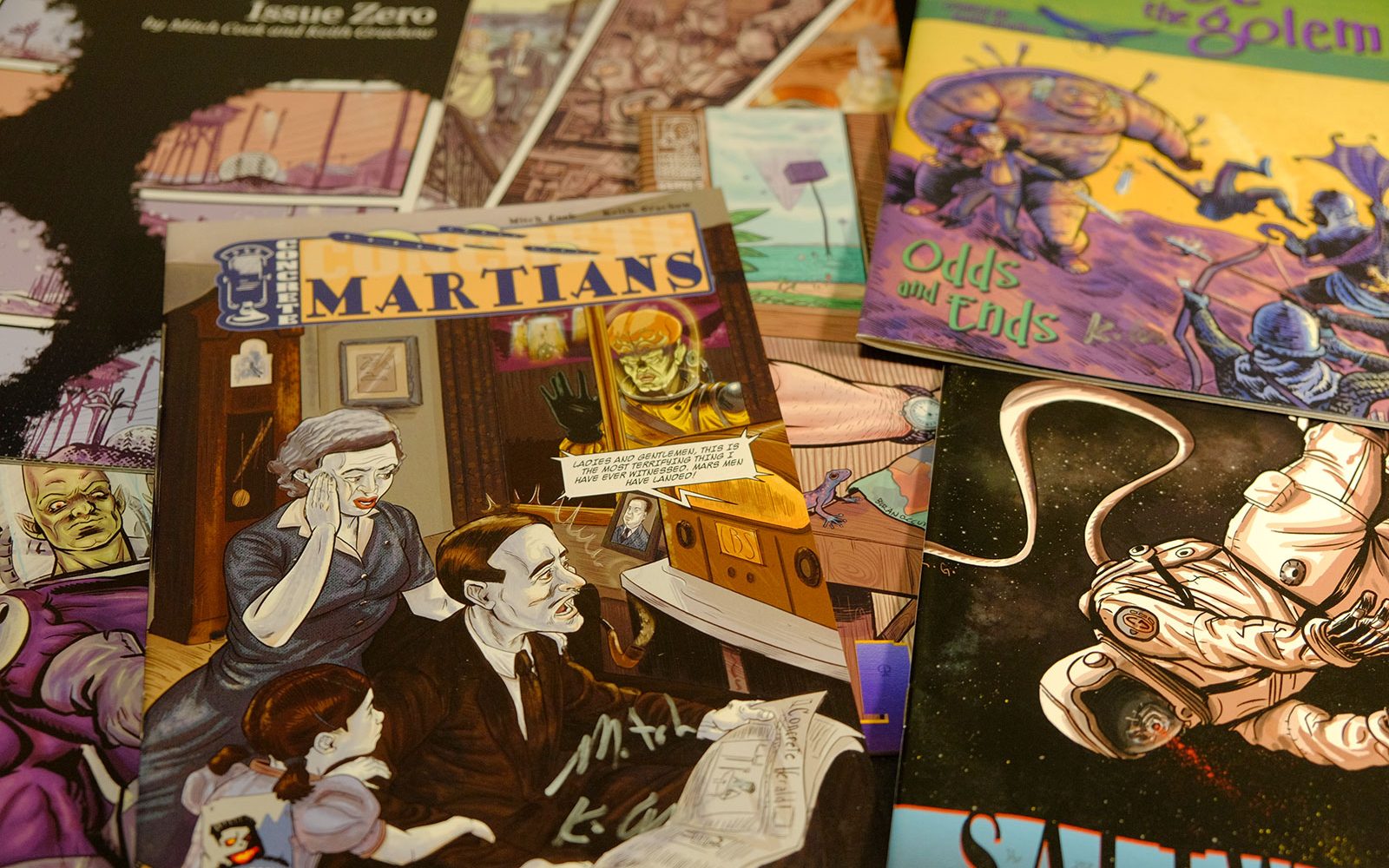
Since the 2020 calendar has been wiped clean of in-person conventions, I thought it would be nice to take a look back and revisit the 2019 Rose City Comic Con in Portland Oregon. Escaping my own table and dashing around the Artists’ Alley, I found myself drawn to an illustrated backdrop with a definite mid-century retro-future vibe to it. And I was immediately accosted by a rather energetic pair of comics creators: Mitch and Keith (or is that Keith and Mitch??). Their chemistry as co-creators was palpable, as was their infectious enthusiasm for their craft. I browsed through their books on display and chatted with them about their creative process and the visual style of their books. After a short while, I realized I needed to get back to my table and after picking up a few of their comics, I made them agree to an email interview.
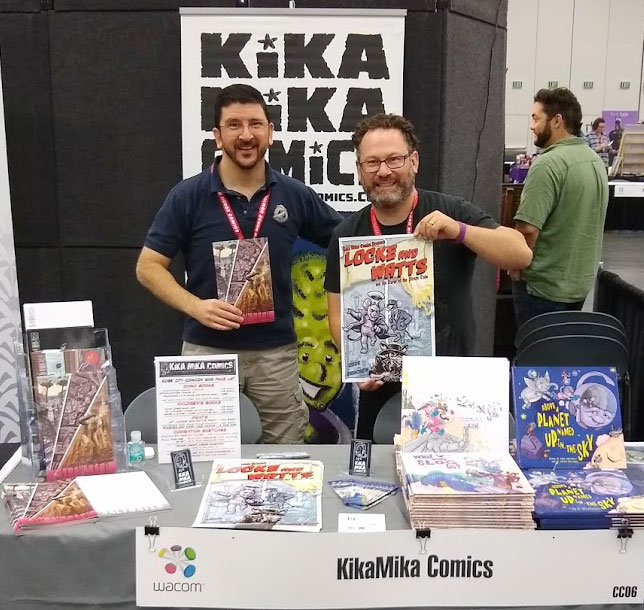
Mitch Cook, writer, and Keith Grachow, artist, are the geographically non-contiguous co-creators of the comics Concrete Martians, Saltwater, and The Pure Land, and more. As I mentioned earlier, I was drawn to the 1950’s visual vibe of Saltwater and Concrete Martians.
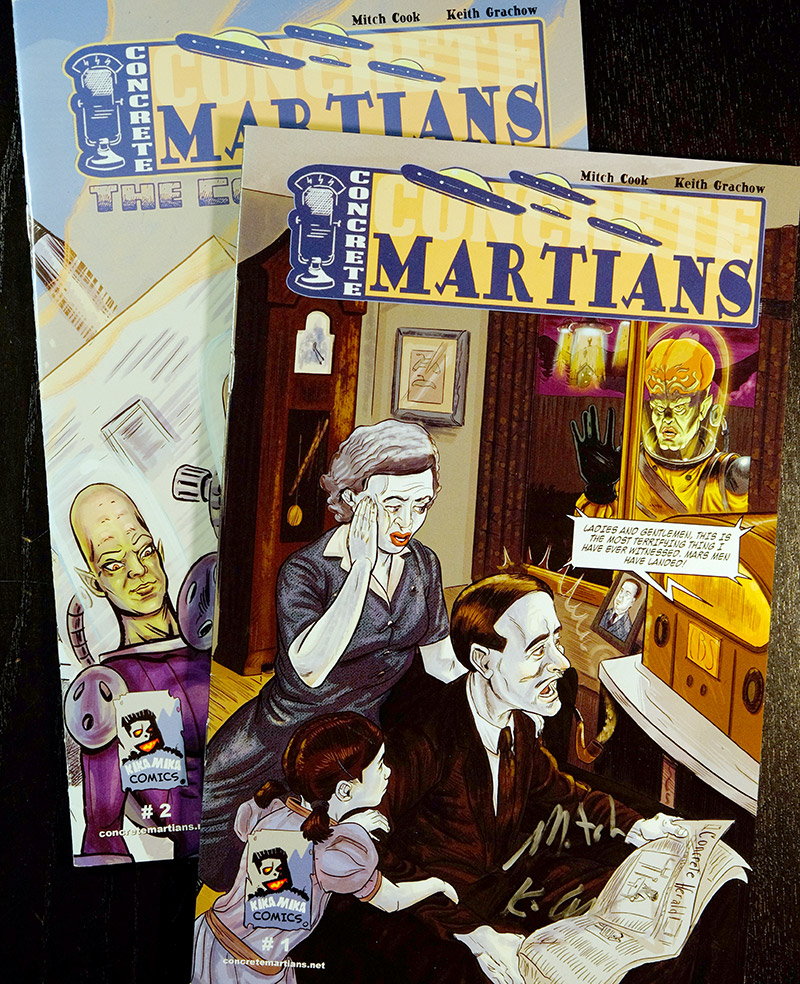
That latter title was their first successful collaboration. Concrete Martians retells the story, from the perspective of its effect on the small town of Concrete, Washington, of the infamous 1938 Orson Welles dramatization of War Of The Worlds. In Mitch and Keith’s books, we learn of the almost literal “perfect storm” that struck Concrete that night of October 30th when, during the War Of The Worlds broadcast, a storm knocked out a local power transformer, plunging the town and its residents into darkness and chaos. “Theater of the Mind,” indeed!
Saltwater is an on-going science fiction series set in an alternate past in which an international coalition launched a Mars colonization mission in 1955. The colony lost contact with earth in 1965 and didn’t know why… until they received a shocking transmission in 2005 informing the colonists that Earth has itself been invaded and colonized by aliens!
Anyway, when I learned that Mitch and Keith don’t even live in the same town my curiosity was piqued and I had to find out more about what drew (heh!) them together and how they collaborated over long distances.
Let’s start with a bit of background. You met in Osaka, Japan, but what was the occasion? What was the Universe up to that managed to bring the two of you together?
Mitch: It’s totally random how we met. We were both in Osaka, Japan, to teach English. I saw Keith sitting by himself (self-imposed exile to focus on his craft) and I kept interrupting him. “Hey, I have an idea for a comic book.” Relentless in my pursuit, he finally caved and listened to me. Ultimately our intended project never got beyond development, but we became friends and acquired a type of shorthand with each other. It has served us well.
Keith: it’s true. I was very focused on my own drawing projects. Mitch was persistent, like an ear worm, burrowing into my brain. Finally the pain was so intense I had no choice but to listen! Jokes aside, I’m very happy to have caved, because over a decade later, we’re still collaborating on really cool projects.
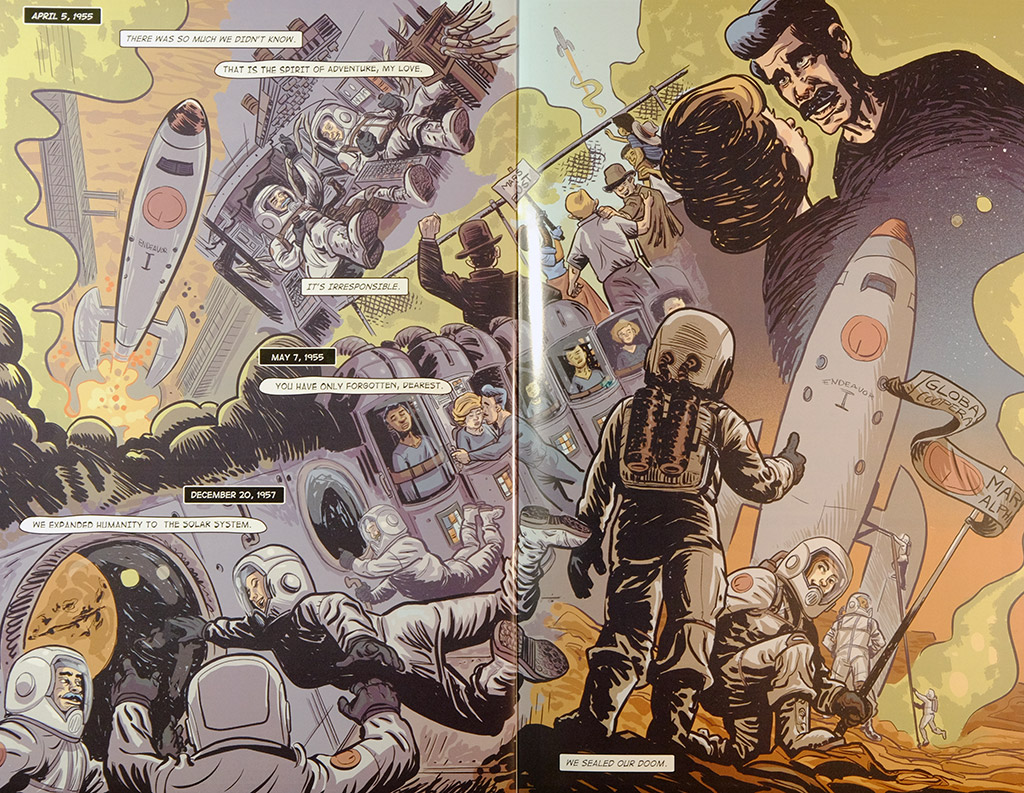
“Concrete Martians” was your first collaborative effort, correct? What did you learn — about the process, about each other, about yourselves — launching this title?
M: “Concrete Martians” was everything. We learned how to work together to complete a goal. But it took a really long time. Distance was one issue we had to overcome, and self-doubt was mine to deal with. I had to learn how to be a pro and he had to guide me with immense patience until I got there. Once I got past my own hurdles and found some courage to put myself out there, it all came together. We took some risks and had a lot of help (financially) to finally see it through. We ran two crowdfunding campaigns. One failed and the other worked. Patience was key. Belief in the story was the other key. Then we put it out there for people to see and were astounded by the reception.
K: Technically, Concrete Martians wasn’t our first collaborative effort, but it was the first to see print. As Mitch mentioned earlier, we had worked together in Japan on a project that never saw the light of day. We had also worked on some practice pitches. All of that had helped both he and I to create a shorthand in the comic book process. By the time I got the script for Concrete Martians, five years into our collaboration, there was a comfort knowing that his script would be solid and that he knew what to expect from me. Also, we had worked through some hurdles that strengthened both our friendship and business partnership.
What’s your workflow like? How does the collaborative process work over the long distance (Seattle to Toronto)?
M: Actually it’s pretty smooth. We have developed a shorthand which makes over the phone, texting, and email communication pretty easy. We have LONG conversations and strategy meetings when we see each other in person. But the process is simple. I get an idea and I flesh it out. I send him a short synopsis and he gives me feedback. If he feels compelled to work on it and we have funds, I write the script. (even without funds I write a script) Then, when we commit to producing it, he makes thumbnail sketches and sends them to me for approval. I either approve of them or ask for some changes or clarifications. This is where I see where we come together with similar ideas or if he sees something completely different. That is when I have to make decisions. Do I accept some of his changes or do I get strict? It usually depends on what I want the panel or series of panels to say. I find a nice mix of ideas this way. So, his influence can and does cause me to accept changes to an original idea I had in mind. Then he goes ahead and completes the pages on a deadline. He sends me completed pages rather than some pages as he completes them. Once approved and edited, we send it to print and ship. Done.
K: I concur. It’s very smooth. I work with all different writers, and each one brings a different voice to the process. I generally work the same way with each one, in regards to my process, but the type of script is always different. With Mitch, he’s very sparse with his words, but clear and to the point. He gives me lots of great direction for scene blocking and character development, but his script allows me the freedom to create the page as I see fit. Amazingly, Mitch often says the pages look pretty close to the way he envisions them, so that means both of us are on the same wavelength. Scary (heh).
What are your “tools of the trade”? What’s your workspace/studio like?
M: Mine is simple. Notepads, books, and my computer. I research and take notes, I think of something I don’t want to forget and jot it down. Then I use my computer to write a script, store reference photos, etc.
K: I work digitally, so a desktop computer with Adobe Photoshop and a pressure sensitive drawing screen, called a Cintiq. Often I’ll do character development in a traditional sketchbook, and then scan or photograph the sketches onto my computer.
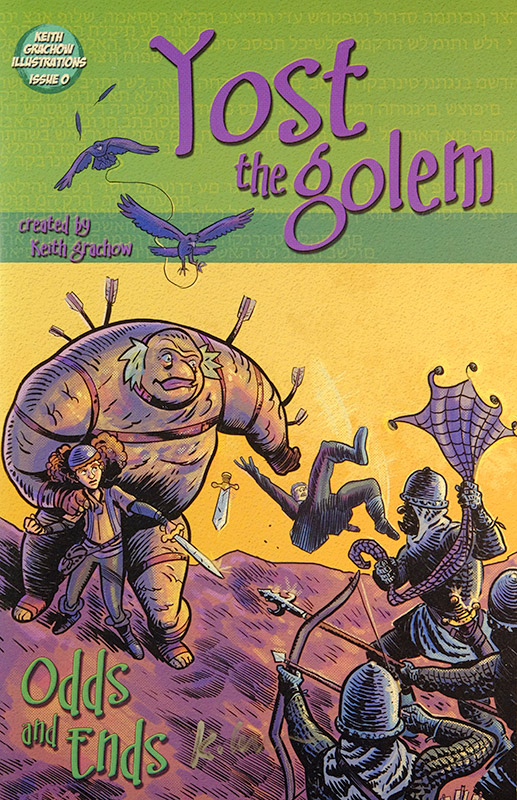
This is a question for Keith: You created Yost the golem as part of a comic book writing workshop. I get the sense that Yost is a bit more than “just something” you created at the drop of a hat. In “Yost the golem” issue 0 you include loads of notes, but even setting aside all of that I still get the sense that Yost is a very personal creation. Is there more to his creation? Can you elaborate on the how and why of his creation?
K: You’re very astute! Yeah, Yost is a personal creation, but actually, he was created kind of spontaneously. As you mentioned, I was taking the Comics Experience class and had planned on using a graphic novel idea that had been rejected by another company. I was hoping to start that project on my own, but Andy Schmidt, the teacher of the class, made it clear it was best to have a short story as it was only going to be five pages. So I had to come up with a new idea in a pinch.
To back up a bit, I had written and illustrated a short story for a Jewish Comics Anthology called SCI for AH Comics. It was a story based on the “Stone Soup” fable which was considered to be of Judaic origin. I’m culturally Jewish, and previously had never thought of writing or creating anything from my heritage, but this story planted a seed.
When I needed an idea for the Comics Experience class, I took this as an opportunity to do another story based on my Jewish ancestry, and since I planned on drawing it as well it had to be fun to draw. So a golem seemed like the perfect idea. Doing a minimal amount of research I learned about the “Golem of Prague” and based my story on that. That’s how Yost was born!
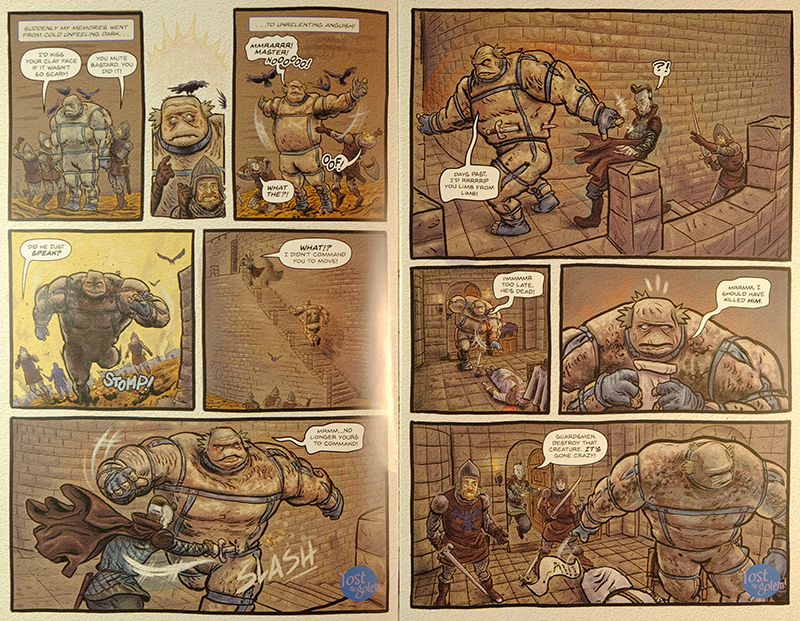
Over the month of working on him and his story, I started to fall in love with his character and realized there was much more to Yost and so I started researching more about golems and also the time and place that he could exist during the middle ages. This opened up a world where a golem could exist in 13th century Spain, living amongst Jews, Christians, and Muslims. That era is a rich tapestry that works so well with the story I want to tell. While I drew the five-page story of Yost’s origin and had it printed, I plan on doing a full graphic novel to really delve into Yost the Golem’s journey.
I’m going to guess that it’s Mitch that has a soft spot for the style and flavor of the mid 20th century. Pulp fiction, noir, furniture with red sparkly upholstery and chrome trim. Tell us a little about that fascination, Mitch.
M: I have no idea why I like that space. I haven’t always enjoyed those genres. But for the stories I have thought of, that period seems to be honest. War of the Worlds, the broadcast, has always fascinated me. So, it is by default that the period works. Since then I have spent a great deal of time in the late 30’s mid 40’s era spaces. I find them comfortable. I am sure that will change.
Related to that last question, for me “Saltwater” has definitely captured that feel of 1950’s American science fiction. Why did you choose to set your story in that decade and not, say, ten years into the future (like, say, 2029)?
M: The thing is, Saltwater is actually set in modern times (2005) but I approached it from the mindset of 50’s American Science Fiction. Mostly because I thought it would be interesting to visit that period and then alter it. Then the “current” time setting would be totally influenced by the alternate history. I have always found it funny how futurists from the past saw their future. So, we decided to play with that idea.
What comic books are on your reading list right now? Do you have an “All-Time Favorite” comic book?
M: I have recently fallen in love with Jeff Lemire’s Trillium. The storytelling is complicated, but he found visual techniques to make it simple. I will never get over the loss of Darwyn Cooke. His storytelling style has inspired many of my own thoughts and opened a lot of doors in terms of possibilities. The New Frontier series is my all-time favorite right now. And I still love cracking open his Richard Stark’s Parker series.
K: I just finished Charles Burns Black Hole graphic novel. It’s a quirky coming of age story with lush inks that make the pages come alive.
Toronto, where I’m from, has a great indie scene, so I’m often reading local creator’s work. Ricky Lima’s Undergrowth is an epic fantasy/sci-fi story that is some of his best storytelling. I’m in the midst of Jason Lapidus and Chris Sanagan’s Group of 7, a World War 1 adventure story about a bunch of crazy canucks!
I’d also have to concur with Mitch in regards to favorite creators. Darwyn Cooke’s Richard Stark’s Parker is one of my go-to books to study for storytelling and character development.
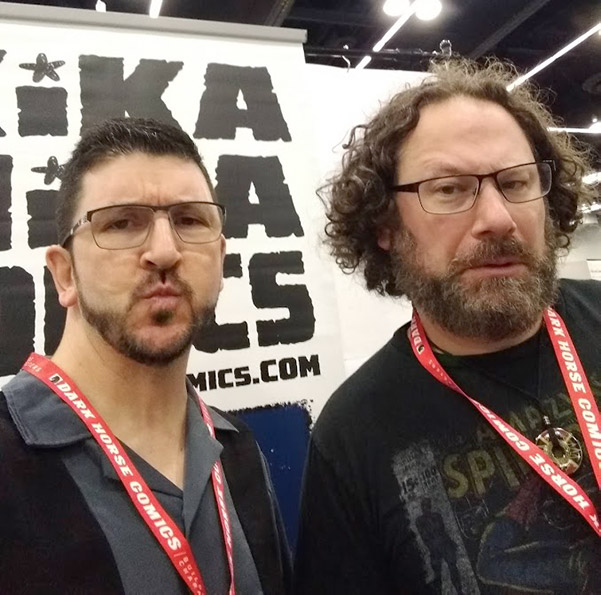
What are your Five Rules To Live By?
M: Just be honest. That covers all my rules.
K: Yeah, I don’t have five rules either, but I’m huge about setting up expectations clearly. Which aligns with my other rule of solid communication. Oh, and being honest is also a good one.
Why comic books? By this I mean: why the “sequential art” format and not straight-up prose or an “illustrated” story?
M: I grew up as a television consumer and got into comics as a teen. I see the world in visual sequences. So, that is how I tell stories. I am currently attempting my first long-form prose book. But I have written several short stories I published on the web site. Several support “Saltwater” specifically.
K: As a kid, I always loved creating my own worlds by drawing characters and settings onto paper and then cutting them out and placing them around my real life. I would then choreograph these intricate and epic storylines and play with them. I also had a fascination with the Saturday morning monster matinees and would want to keep the movies going, so I wrote and drew my own comic books based on Godzilla fighting new monsters I created. I guess the visual storytelling medium hooked me at an early age and never let go.
What/who are your creative influences?
M: Hitchcock, Orsen Welles, H.G. Wells, Spielberg, Henson, Murrow, Disney, and Serling.
K: Michaelangelo, Da Vinci, Alfonso Mucha, John Buscema, John Byrne, Chris Claremont, Stan Lee, Mike Mignola, Alfred Hitchcock, Steven Speilberg, off the top of my head.
What advice would you give to someone seeking to create their own comicbook?
M: Stop making excuses and write. Do it for you.
K: Like Nike says, “Just Do It”.
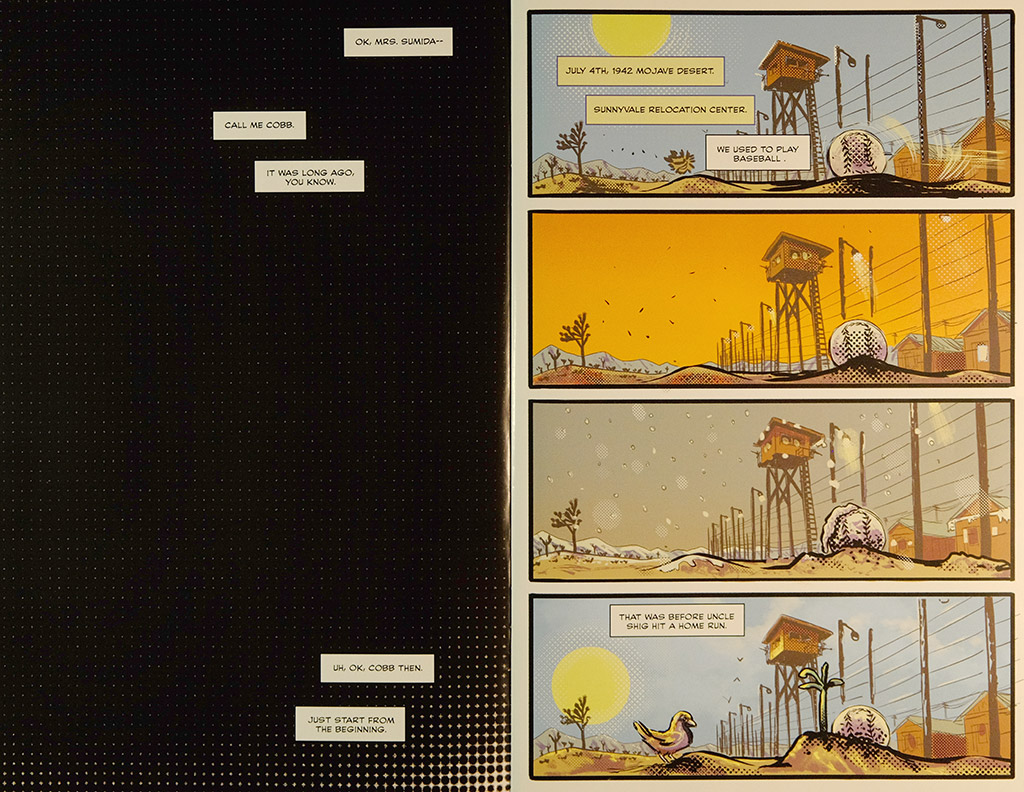
Finally, what do you have in the works right now? When will we get “Saltwater” issue 4?? 🙂
M: The Pure Land is super high on my priority list but requires a lot of funding. It’s a color and texture-rich project and also a long graphic novel. It’s a passion project of mine. It’s a missing person mystery set in an Internment Camp in the ’40s. So, in the meantime, I have found a way to fund our first Kids Comic book. Really an all-ages book. There is so little for Kids at Comic Book Conventions. KikaMika Comics logo is a character Keith just made from necessity and I immediately got an idea from it. I named him B’Ingo. A young Martian with dreams of invasion glory. The first book is “B’Ingo Invades. . .The Zoo.”
We hope to sell enough of our current inventory to finally fund Saltwater #4 through #6 “Children of Mars.” Stay Tuned.
K: In addition to B’Ingo, I’m working on the next issue of Donnybrook for Messbucket Comics, which is a “Slapshot” like story about imagined NHL teams behind the scenes drama and antics. I’m also on a secret project I’m not at liberty to talk about, but it involves horror. And when I’ve got spare time, I chip away at Yost the Golem. I’m always writing that story in my head, and when it gets too full and unbearable for me to keep in my noggin, I get it down on the proverbial page. I’m also working on a couple of pitches with other writers I’ve been collaborating with.
Thanks for taking to time to answer all my questions! I wish you both good fortune and I’m looking forward to “Saltwater” #4!
You can find out more and purchase Kika Mika Comics here.


